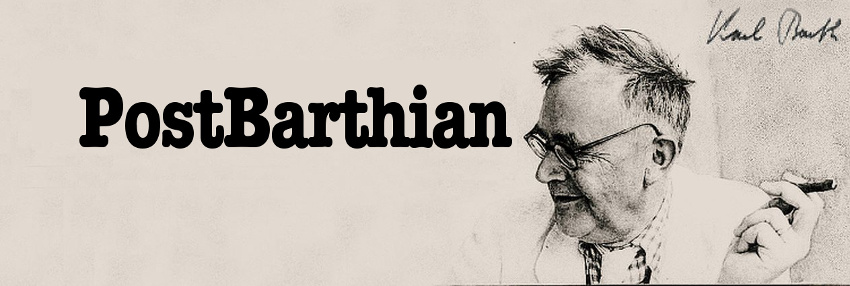 Stanley J. Grenz (1950-2005) was a contemporary Baptist theologian who died tragically early, and had the potential to become a theologian known for centuries. A friend of mine described Grenz as a genius like Karl Barth, but accessible unlike Barth. Grenz wrote many books, the most famous is his systematic theology: Theology for the Community of God, of which I've only read selections but enjoyed it more than the more popular and comparable Systematic Theology by Wayne Grudem.
Stanley J. Grenz (1950-2005) was a contemporary Baptist theologian who died tragically early, and had the potential to become a theologian known for centuries. A friend of mine described Grenz as a genius like Karl Barth, but accessible unlike Barth. Grenz wrote many books, the most famous is his systematic theology: Theology for the Community of God, of which I've only read selections but enjoyed it more than the more popular and comparable Systematic Theology by Wayne Grudem.
I've been reading several Protestant Church History books this spring, and the most recent was Grenz's Primer on Postmodernism that was commissioned from him by Intervarsity Christian Fellowship. The book is a summary of Postmodernism and the philosophers who represent the Postmodern World-View. In the last chapter, a Christian Gospel response to Postmodernity is included that praises Postmodernity's criticism of Enlightenment and Modernistic worldviews, and also criticizes its rejection of all metanaratives and pluralism. Overall the book is a plain summary of Postmodernity that's fair (in my opinion) that is very informative rather than bashing, especially with its overview of the primary Postmodern scholars and flash biographies of them: Michele Foucault, Lyotard, Derrida, and Rotary.
I've typed in by hand the following long quotation of a justification for Postmodernity from the foundation of the science of Physics, that is incredibly helpful for justifying Postmodernity and overturning ignorant babeling about Occam's Razor and Logical Positivism that has long since been debunked by Thomas Kuhn's Scientific Revolutions and various works by Karl Popper.
The New View of the Physical World
Modernity was born out of an intellectual revolution. The specifically scientific dimension of that revolution was sparked by Galileo (1564-1642) and reached its climax with Newton (1642-1727).
Galileo's innovation consisted in his attempt to interpret the world from a strictly quantitative point of view. Experimentation that yields quantifiable results (i.e., numbers rather than nonnumerical qualities) became the central technique of the emerging scientific enterprise. The focus on numerical measurements gave scientists the sense that they were practitioners in a field of inquiry that produces exact and unambiguous knowledge. Organized into equations, such knowledge gives expression to laws or patterns within nature itself and therefore can be used to predict other "natural" occurrences.
The impulse that Galileo and Newton provided led modern thinkers to reject the organic view of the world that dominated the ancient understanding and to replace it with a mechanistic understanding.
The mechanistic outlook reduces reality to a set of basic elements or elementary particles and forces (e.g., electromagnetism and gravity). Each elementary particle embodies an essence that determines its nature and value; each is what it is apart from other particles. These autonomous particles come together to form other particles. These autonomous particles come together to form various kinds of natural "machines." Finally, the mechanistic view suggests that these elements interact with each other mechanically -- in a sense, that they push each other around -- but that these interactions do not affect the inner natures of the particles.
Armed with the mechanistic model, modern scientists busied themselves with the task of unlocking the mysteries of the universe. And on the basis of the model, which appeared to offer an unassailable view of the world, the modern scientific enterprise celebrated discovery after discovery. As a result, science commanded near-universal respect in the modern society, and modern people looked to the scientist for the answers to life and for guidance along the pathway toward the betterment of the human situation.
In the midst of its greatest technological triumphs, however, certain foundational aspects of the modern scientific worldview were shaken from within. The most devastating internal challenge came from physics, the discipline that had provided its firmest foundation. Discoveries in the early twentieth century called into question modern assumptions that the universe displays an internally consistent order that the human mind can easily come to understand and picture. And the mechanistic model that earlier had appeared to be beyond question came under increasing fire as evidence increasingly suggested that there is much about the universe that is virutally indescribable and even unimaginable.
At the beginning of the twentieth century, Max Planck declared that on the atomic level, energy comes in distinct "packets" (quanta) rather than in a steady flow. Albert Einstein, in turn, noted that light is not only a wave but also a shower of individual packets of energy (photons). Niels Bohr related the phenomena to the behavior of electrons. Electrons do not orbit atomic nuclei at random distances. Rather, they sit in specific orbits that are multiples of a fundamental quantum of energy. In addition, they "jump" from one orbit to another as energy is applied to the atom or as they give up that energy. Then Louis de Broglie proved that all matter -- including the electron -- has both particle and wavelike properties. Quantum theory was born, and our view of the world has not been the same since.
Paralleling the development of quantum theory was another important series of discoveries that we cumulatively refer to as "relativity theory." By means of his "special theory of relativity," Einstein undermined the seemingly commonsense notion that space and time are absolute. He disproved the centuries-old belief that length and time can be measured against absolute standards by showing by showing that a rocket traveling at high speeds will shrink slightly in comparison to its earth-bound counterparts and that a clock on that rocket will run more slowly. This theory also implies that matter and energy are not independent constants but are reciprocally related; the one can be changed into the other according to his famous equation, E = mc^2.
Einstein's "general theory of relativity" is equally far-reaching, though not as well known in wider society. This theory postulates the mind-boggling idea that gravity is essentially a curvature of the space-time continuum.
Like relativity theory, quantum physics reveals some startling features of the universe that undermine both the modern mechanistic model ofthe world and the modern assumption of scientific certitude. For example, there are no commonsense models that help us reconcile the dual nature of nature of matter and energy -- the face that they sometimes act like waves and sometimes like particles, depending on the way we examine them. Likewise, the familiar image of an electron orbiting an atomic nucleus like a planet orbiting the sun has proved wholly inadequate to characterize what really goes on at the subatomic level. Physics in this environment is not nearly so mechanical and clear-cut. Evidence indicates that subatomic particles do not necessarily move in a continuous manner, for instance: they are able to travel from point A to point B without passing through each of the points in between. And in his now-famous Uncertainty Principle, Werner Heisenberg notes that we can determine with certainty either the position of a subatomic particle or its momentum, but we cannot determine both these characteristics for any given particle at any given time. Certainty simply evaporates at the subatomic level, leaving us with little more than probabilities and paradoxes.
Newer theories overthrow the idea of a "substantial" universe altogether. The universe is not composed of individual particles possessing specific essences within themselves, say the new physicists; elementary particles are actually far more dependent on their context -- their relationships to one another -- than the mechanistic model anticipates. In fact, at its most fundamental level, physical reality does not seem to be composed of independently existing particles at all but of dynamic relations.
Quantum theory also demands that we acknowledge the limitations of scientific inquiry. The modern scientific enterprise is built on the assumption that the scientist approaches the universe as a neutral observer. The world is an object that the scientist probes. Contemporary physics, however, has effectively exploded this understanding.
Adherence to a set of procedures accepted by the scientific community may ensure relative objectivity on the part of the observer, but no experimental protocol can produce a purely objective, uninvolved observation. In observations performed at the subatomic level, it is easier to see the operation of the general principle that the scientist's act of observation itself affects the object of his or her investigation, because the techniques of observation are so large and clumsy and the observed phenomena so delicate and ephemeral. But the point rings true in other sorts of observations as well: we cannot neatly separate the observed object from the observing subject. This overturns the modern assumption that "facts" are present in nature independent of some particular observer. Postmoderns insist that we are not spectators who approach the world but rather participants in what we week to know.
Recent developments place another limitation on the scientific enterprise as well. Modern science is erected on the assumption that the universe is open, at least in principle, to full and complete description, that when nature is subjected to the scrutiny of detached, impersonal scientific observation of facts, it yields objective knowledge about its deepest secrets.
When Heisenberg formulated his Uncertainty Principle in 1927, however, he established that there is an essential indeterminacy about all phenomena that no kind or amount of observation can overcome. In a sense, he established the point that the universe is ultimately an unfathomable mystery. David Bohm has proposed an intriguing alternative to Heisenberg's principle known as "quantum potential" -- the notion that all particles are linked together in a huge interconnected web that enables each of them to know instantaneously what the others are doing. In either case, however, the realm of today's physicist is no longer the simple world of independent particles depicted by the mechanistic model.
Developments in physics since the advent of relativity theory and quantum physics have come at an overwhelming rate. The list of identified subatomic particles has grown. Black holes have been discovered. The Big Bang has been plotted in minute detail. And physicists tell us we live on the curved surface of an expanding universe.
The new discoveries have led contemporary scientists to an increasing awareness of the complexity of the universe. In fact, some scholars speak of the advent of a third scientific revolution characterized by a new "physics of complexity." The "explosion of complexity" is laying to rest the assumption that we can gain unambiguous knowledge of the universe. The emerging consensus is that ours is a relative and participatory world.
The complex world of the new physics is vastly different from the simple, static, objective universe of Galileo and Newton. It is not so much a creation as a creating. And the universe is not a existing entity that has a history; rather, it is a history.
pages 49-53, Primer on Postmodernism, Stanley Grenz
Related: Derrida, Einstein, Galileo, Grenz, Karl Popper, Lyotard, Michele Foucault, Newton, Physics, Postmodernism, Postmodernity, Quantum Mechanics, Relativity, Rotary, Stanley Grenz, Stanley J. Grenz, Thomas Kuhn



February 10th, 2017 - 10:36
Thank you, what an awesome and accessible description. I’ll definitely be returning to this again.